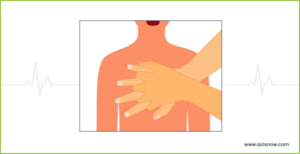Table of content(s)
- Introduction
- How deep should chest compressions be for CPR?
- What is the compression rate for CPR?
- How to perform CPR with the right compression rate?
- How does music help with compression rates?
- How to assess if the CPR compression rate is enough?
- When not to start CPR?
- Key takeaway
As new research and recommendations come up, CPR as a crucial life-saving skill continues to evolve. Although it is a common skill and most of you have heard about it, how many are actually familiar with it? Given the importance of accurate chest compressions and rates in CPR, it is essential for everyone to learn the basics of CPR.
There is a right and a wrong way to perform chest compressions. If you are considering a career in the medical field, it is crucial to understand how to administer chest compressions. You must get the basics right to know how hard it is to push down and at what rate it could mean the difference between life and death for someone experiencing a medical emergency. Keep reading to get the basics of CPR compression depth.
How deep should chest compressions be for CPR?
You can tell when someone needs CPR when they stop breathing. If this happens, start CPR right away. The most important factors to consider are the rate and depth for chest compressions. For effective chest compressions, you must ensure that you are applying enough pressure. The recommended depth tends to vary for children and infants. The differences are as follows:
2–2.4 inches for adults:
The updated CPR guidelines of 2015 state that the compression depth has increased from 2–2.4 inches. This is applicable for adults, regardless of whether the patient is male or female. So what is the recommended depth of chest compressions? When performing adult CPR the depth of compression should be at least 2 inches, but no more than 2.4 inches. This is the depth of chest compressions, which will help improve patient safety. regardless of whether the patient is male or female.
Before 2015, the recommended depth was greater. The research revealed that compressions delivered beyond the maximum depth of 2.4 inches caused an increased risk of injury, such as fractured ribs.
It is worth noting that women are not very likely to get CPR. Only 39% of women received CPR from bystanders, compared to 45% of men. This is because rescuers often fear accusations of sexual assault or injury.
Additionally, women also have less heart disease and exaggerated incidents. This causes a drop in heart disease awareness among younger women. The rate of CPR compressions went from 65% in 2009 to 44% in 2019.
1.5 inches for infants and 2 inches for children:
As children and infants have smaller bodies, the recommended depth of chest compressions is lower. The industry guidelines state that the rate is 1.5 inches. Perform this using two fingers. The depth increases to 2 inches, and you must perform compressions with the help of one hand. Once a child becomes an adolescent, especially depending on their size, the recommended adult compression depth can be applied using both hands.
Place the hand heel on the child’s chest center. Place the other hand on top and lock the fingers. Push down two inches, or about one-third of the chest diameter. The depth of compression is critical here. Place the shoulders over the hands and lock the elbows. Push down quickly and strongly at a rate of 100–120 per minute. If you fail to reach a depth of two inches with one hand, you will need to use two. You can also give two breaths every 30 compressions.
Ventilation is crucial in neonatal and pediatric resuscitation. While giving CPR to an infant, push 1.5 inches with two fingers on the infant’s breastbone. Use your thumbs to provide the right depth. The quality and depth of the compressions are critical. Use the hand heel if you do not reach 1.5 inches using two thumbs. Use the hand heel if you cannot reach 1.5 inches using two thumbs. Give two rescue breaths after 30 chest compressions. Continue the cycles until the infant starts to recover or a healthcare professional arrives.
What is the compression rate for CPR?
You now know how deep chest compressions should be; however, what about the rate? This is another crucial component that talks about the rate or speed at which compressions are delivered.
Before the recent update in 2015, the recommended rate was at least 100 compressions per minute. It was discovered that the rescuers were pushing so hard that they weren’t achieving an adequate depth of CPR. The guidelines have thus evolved, and these are the changed guidelines:
- 100 to 120 compressions per minute.
- This equates to one to two compressions every second. Unlike the recommended depth of CPR compressions, the recommended rate of compressions in CPR is the same for adults, children, and infants. If you know how deep chest compressions must be for each age group, you can apply them at the same rate to all.
Read more: Primary Assessment in ACLS
How to perform CPR with the right compression rate?
High-quality CPR ascertains whether a patient will survive cardiac arrest or not. Effective chest compressions are not always delivered. In fact, it can be inconsistent, tiring, and challenging. Here are the industry guidelines to consider:
- If you see an unconscious person, see if they are responding. Tap them on the shoulder and ask them if they are okay.
- If you do not see any sign of response or the person is not breathing, call 911 immediately and inform them of the emergency.
- Before performing CPR, place the person on their back. Place them on a flat surface and ensure that there is no material that’s obstructing their airway.
- Keep your arms straight and lock your elbows well.
- Start CPR with hard and rapid chest compressions. This is applicable to both first responders and untrained people for hands-only CPR.
- Minimize interruptions in chest compressions.
- Change compressions every 2 minutes or less.
- If you are not very experienced in CPR, check for a pulse and breathing prior to starting CPR.
Do not worry if you are not trained in CPR. You can still perform hands-on CPR even if you are not trained. Push in the chest center fast and hard at a rate of 100–120 pushes per minute. Allows the chest to return to its normal position after every push. Mouth-to-mouth breathing is not required in these cases.
Do not stop the procedure until a healthcare provider arrives. Repeat the procedure if you do not get any response after a cycle of 30 chest compressions and 2 rescue breaths.
You can also time the pushes to the rhythm of the song ‘Stayin’ Alive’. Continue with chest compressions until paramedics arrive or some with formal CPR training come to help.
If you are trained in CPR, then there is nothing like it. Start the compressions if you cannot hear breathing or a pulse within 10 seconds. Start CPR within 30 compressions, followed by two rescue breaths. If you are certified in CPR but are not sure how well you will do it, perform it at 100–120 per minute.
How does music help with compression rates?
What happens if you are not in a hospital but in a workplace that needs CPR training? You may know the depth of CPR compressions, but you do not have ready access to a metronome, or you are a bystander trying to help someone. If you already know about chest compressions, a great tool for ensuring compressions is to think of a song that has a beat within the same range.
The song Stayin’ Alive by the Bee Gees is one example used in CPR classes to help students achieve the desired speed. The song has a 103 beats per minute (BPM) tempo.
How to assess if the CPR compression rate is enough?
Effective CPR compressions are a must. Excessive compressions are harmful and can break the patient’s ribs and lead to internal injuries. On the other hand, too-gentle compressions will not pump blood effectively. This may result in death.
You can achieve optimal compression depths for CPR with practice. Keep in mind that the amount of force required to pump blood through the body adequately is greater than you may think. Apart from working in a healthcare setting, you can take CPR courses to ensure you know the right way to help people with this technique.
When not to start CPR?
There are some emergencies when you should avoid performing CPR. This includes instances when you notice signs of life or feel tired. You may also notice signs of death or injuries. Do not start CPR in these conditions.
Read more: Is medical training legit?
Key takeaway
By now, you must have understood how crucial it is to learn ways to perform CPR correctly. Cardiac arrest is a common and global phenomenon. This can happen to anyone. You must be prepared, whether you find yourself in a similar situation or if a loved one suffers cardiac arrest. With this essential knowledge, you are now one step closer to getting your CPR certification.
When wondering ‘what is the recommended CPR compression depth?’, the first thing you must do is assess the build and age of the person. The compression strength and depth are not the same for everybody. While adults need more force, infants need less force. To perform CPR effectively, it is ideal to have formal training. Get an affordable CPR certification and learn at your own pace.








